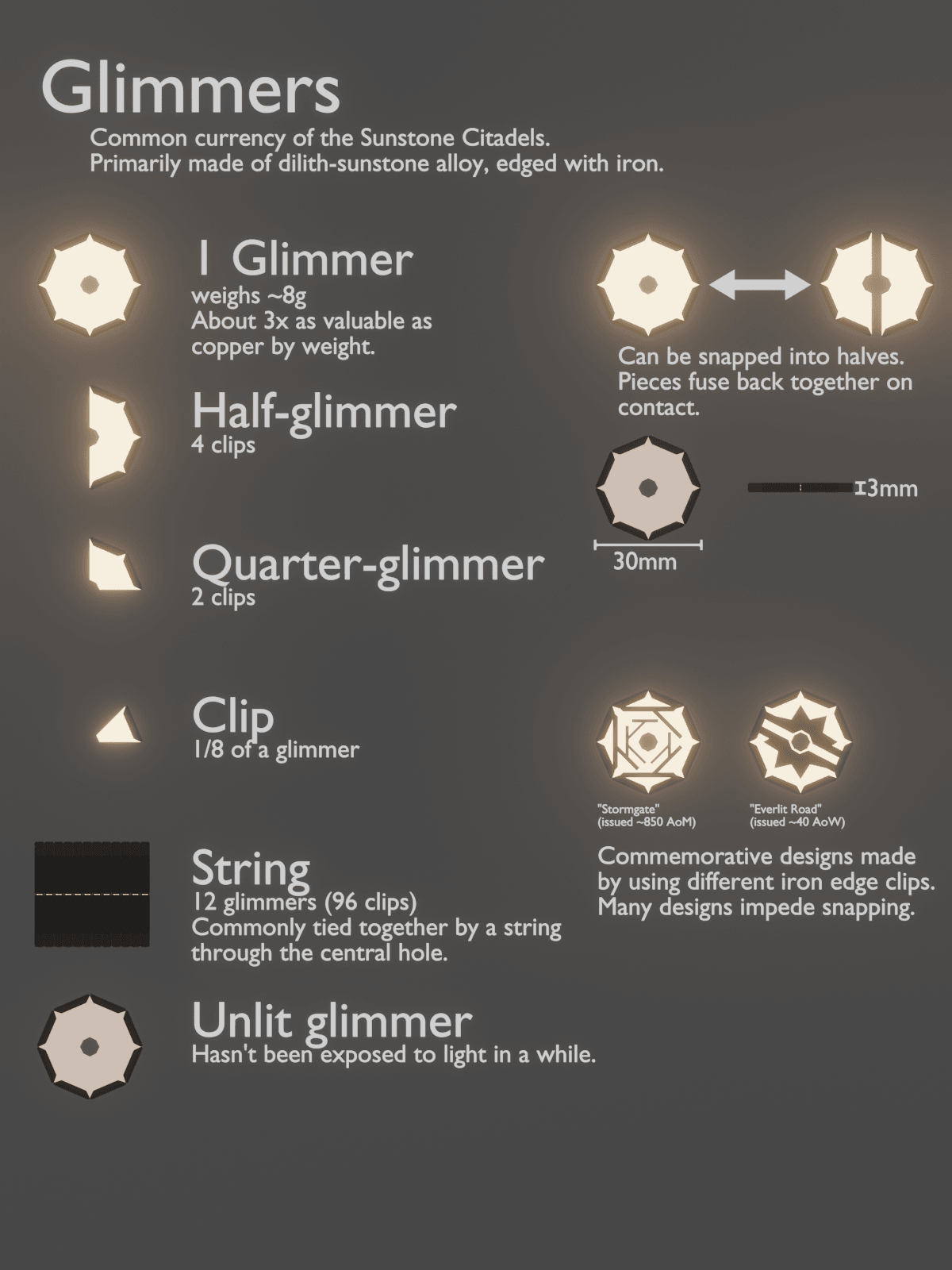Glimmers
Glimmers are the common currency of the Sunstone Citadels, made from a dilith-sunstone alloy of the same name, and edged with (usually) cast iron. They're a rare sight in other regions, even neighboring ones, as the Citadels also use Vault-standard marks for higher denominations.
Origins
The northern lands are said to be cursed twofold, with cold and dark spirits. The former is reasonably simple to deal with- simply bundle up and grow hardier crops. Not ideal, but relatively straightforward. The latter, however, is much more literal than one may expect. Any patch of darkness in the region will gradually become infested with aggressive spirits known as haunts, which seemingly appear from nothing. Haunts are human-sized, slightly transparent, and typically bipedal in appearance, with sharp-tipped tentacles sprouting from various points. These tentacles can pierce through flesh after building up sufficient momentum. Their only apparent purpose is to devour sentient life, which they do so with gusto, mindlessly attacking all people in sight. So those who settled the region had only one recourse: keep everything permanently lit. At first, they used relatively mundane means to do so- torches and bonfires. However, the most common tree within the region is known as the smokewood for a reason (two, actually- the double meaning played a key part in the name sticking). Eventually, they settled down with the aid of sunstone: a mineral which appears in large deposits on the region's surface and soaks up sunlight, releasing the energy once it gets dark. It was integrated into their architecture, intended to keep entire settlements permanently lit with minimal maintenance. Hence their civilization's name: The Sunstone Citadels. While large blocks of sunstone were used in construction, even their architecturally-focused stone magics weren't enough to truly eliminate waste, and they were often left with fragments and dust of leftover sunstone. With neither sustainable source of the mineral nor guarantees that they'd find many more deposits throughout the region (for all they know, the large deposit they'd found was a fluke- after all, they'd wandered for months, if not years, before stumbling upon it), they made efforts to avoid wasting these leftovers. Various preservation methods were attempted, and they eventually arrived at alloying sunstone dust with dilith crystal, creating a material which came to be known as glimmer. Glimmer retained dilith's self-repairing and cold-welding properties, making it perfectly recyclable in a way that pure sunstone wasn't. However, while transparent, dilith lacked perfect optical clarity, resulting in a significant loss in brightness from the sunstone kept inside. Nevertheless, it was acknowledged as a better option than simply throwing the sunstone away. Before serious efforts to integrate glimmer into architecture occurred, surveyors discovered not one, but multiple large deposits of sunstone- initial fears of the mineral's scarcity were unfounded. The northern lands are practically devoid of all ore but iron, and difficult to reach from the rest of the continent. While the rich may use silver and gold, the metals have enough value as to make them impractical for common trade, and little to alloy them with for coinage. Therefore, glimmer became the common currency of the Sunstone Citadels.Make
Glimmer coins are eight-sided, edged with cast iron. They're roughly 3cm in diameter and 3mm in thickness, weighing around 8g. The iron edges of a glimmer aren't connected to one another: this is a deliberate decision, both for ease of manufacture, and to allow the glimmer to be split into fractions. Unlike metal coins split this way, glimmer's property of cold-welding with itself means that such pieces can easily be rejoined into a coherent piece. The octagonal hole at their center also aids in making sure that pieces break cleanly. An eighth-glimmer is usually called a 'clip', as such an object would contain a single iron clip. Twelve glimmers forms a 'string', as they're commonly held together in such quantities by threading a string through their central holes, often with thin wooden plates on either end to distribute stress on the clips rather than the glimmer itself.Value
A glimmer is worth about the equivalent volume of copper within the citadels (about three times as valuable by weight). A quarter-glimmer will buy a loaf of decent bread: a day's worth of calories for a non-laborer. Larger transactions by the wealthy typically use the continental standard of gold and silver marks from the Abyssian Vault, further limiting the spread of glimmers to other cultures. The local exchange rate is usually around 60 glimmers (5 strings) per silver mark. While neither exceptionally rare nor valuable, glimmers are pretty and unique, which goes a long way in their valuation for international trade. Although the regional conversion rate to gold may be something like 600:1, there are plenty of one-offs where an excited foreigner sees the coins for the first time, perhaps not even realizing that they're currency rather than crafts, and drastically overpays. The Citadels have always been largely isolated from other regions due to the difficulty of travel in the region, and consequently see relatively little small-scale trade.Cultural Significance
There are common sayings about bright coin purses indicating that money has changed hands- glimmer has sunstone dust in it, so it soaks up sunlight to maintain luminescence. Bright coins are viewed in a favorable light, usually indicating a payday/transaction. There's also a superstition of bright coins chasing away dark spirits (even though loose space between coins in a small bag isn't big enough to generate haunts)- a cultural disdain for hoarding resources. Conversely, letting their money darken is a way of saying that somebody is a miser. Long strings of glimmers are sometimes hung up around houses and such, or worn as jewelry. The latter is said to help ward off formless spirits, especially when traveling. While the added light from a string of glimmers is quite negligible in most cases (especially since handheld sunstone torches/lamps exist), it's not nothing, and can serve in a pinch. Curtains of glimmers are sometimes used as room dividers in more expensive homes, as they maintain light transmission while occluding vision. It's the closest that most can get to true sunstone, as all solid sunstone is considered property of the local ruler. The fact that a silver mark is worth about 60 glimmers (5 strings) has resulted in the term "five-stringer", denoting a person who has severely overestimated their own value. Stems from the idea of a person who thinks themselves above 'the common folk' because they can use 'real' international standard currencies, despite literally only having one of the smallest denomination of coin.Manufacturing process
The easiest way to make a glimmer is actually through arcanism: the material breaks very cleanly, making it well-suited to being cut with arcane projections. A half-decent mage could easily cut thousands of glimmers from a sheet per day after setting up an appropriate implement. Otherwise, working with manual punches take longer, but not prohibitively so. The iron edges take a bit more work, but are cheap and easy to make.
Glimmersmiths are tradespeople dedicated to fixing or neatening up existing glimmers, as hand-rejoined coins can be quite uneven, and piles of clips fused together oddly can sometimes occur. In smaller settlements, this may simply be a secondary duty of the local blacksmith, while larger cities may have one or more dedicated glimmersmiths.
The real limiting factor is sunstone accessibility: this is typically closely controlled by the local government, which has to balance the use of sunstone to make glimmers with its potential for construction projects. While originally made from excess sunstone, the desire to mint currency has made many cities turn raw, workable sunstone into glimmer. Chipping away at existing architectural sunstone is a capital offence, as it potentially endangers the entire settlement's safety (especially in the event of a haunt siege).
Magnetization of clips has been experimented with by storm mages, though the concept never spread past an initial run- many found it annoying, especially when they ended up finding glimmers stuck to their plated coats.
Commemorative markings typically exist as extensions to clips, rather than being etched into the glimmer itself.
Denominations
'One glimmer' describes a full coin. A clip is an eighth of a glimmer. A string consists of twelve glimmers (traditionally strung together).Exchange rate
Historical average exchange rate is 60 glimmers (5 strings) per Vault silver mark.
Item type
Currency & Deeds
Manufacturer
Remove these ads. Join the Worldbuilders Guild












Daaaaaamn saw this on reddit! This is incredible! I love this concept - definitely giving your world a follow